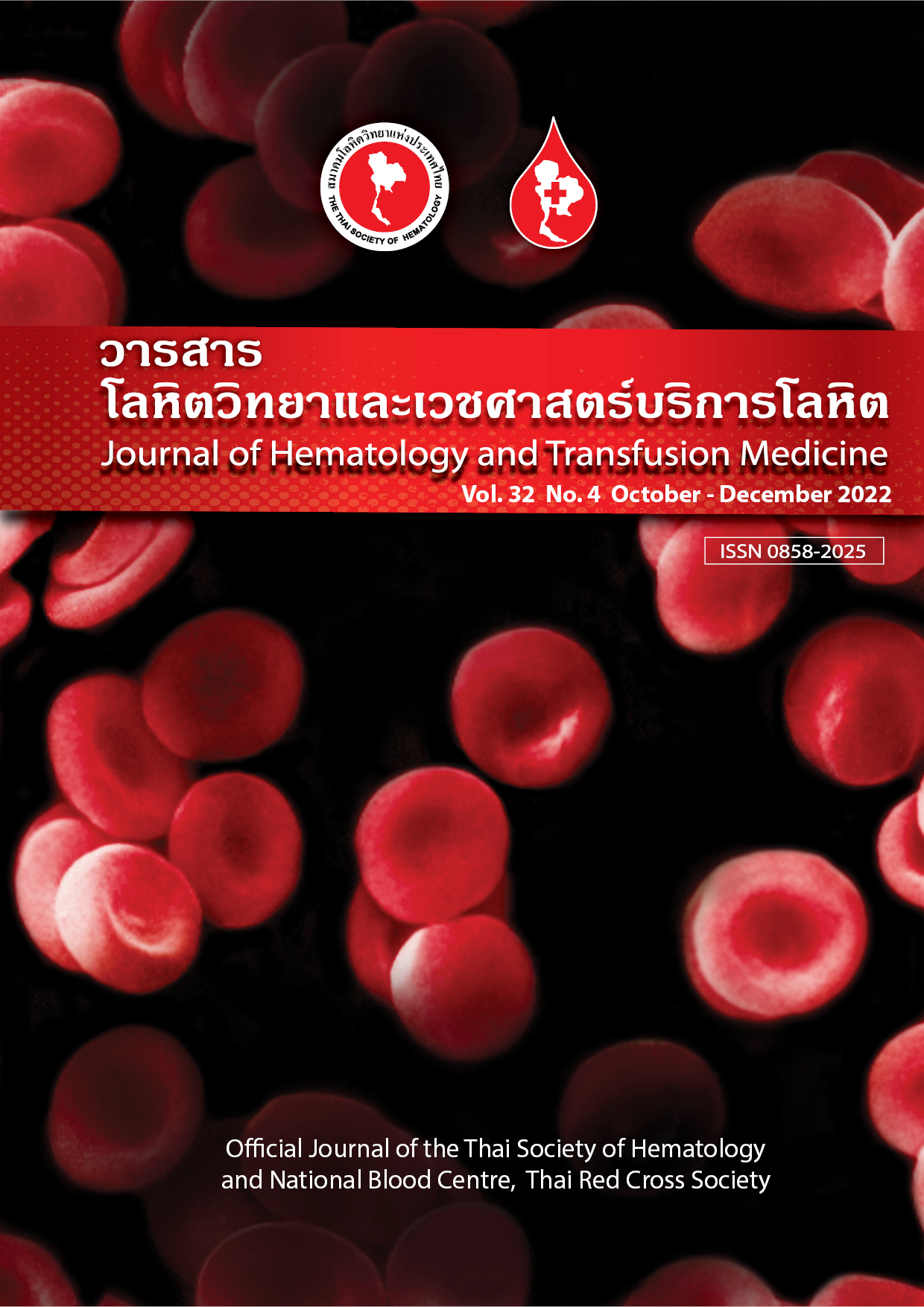ความชุกของการตรวจพบเชื้อไวรัสตับอักเสบซีและการตรวจติดตามผู้บริจาคโลหิตของภาคบริการโลหิตแห่งชาติที่ 8 จังหวัดนครสวรรค์
Keywords:
ตรวจโลหิตยืนยัน, ไวรัสตับอักเสบซี, ผู้บริจาคโลหิต, Confirmed test, Hepatitis C virus, Blood donorsAbstract
Abstract:
Introduction: Donated blood will be screened for transfusion transmitted diseases to test infections for patient safety. If the screening test is reactive, the blood test of the donors must be follow up before re-entry. Objective: To study the prevalence of anti-HCV reactive in blood donors of the Regional Blood Centre VIII, Nakhonsawan province and follow up. Materials and Methods: The study is based on donor data record from 2012 to 2020 of the anti-HCV reactive donors who returned to follow up the blood test results at the Regional Blood Centre VIII, Nakhonsawan province. Results: The anti-HCV reactive of 834 from 355,712 blood donors, 0.23%, consist of male 52.65% and female 47.35% which 528 returned for repeated tests 63.31%. After confirmed the test results, they were divided into three groups, re-entry, inconclusive and the permanent deferred with the proportion of 18.37%, 60.23% and 21.40%, respectively. Furthermore, 2.27% of the re-entry groups the donors had reactive blood test result. Conclusion: Blood donors who had anti-HCV reactive result was 0.23%. The blood donors returned for follow up 63.31%. After repeated blood test, re-entry, inconclusive and permanent deferral were 18.37%, 60.23% and 21.40% respectively.
บทคัดย่อ
บทนำ โลหิตจากผู้บริจาคจะถูกตรวจคัดกรองเพื่อความปลอดภัยของผู้ป่วย โดยเมื่อตรวจพบว่ามีผลการติดเชื้อจะมีการติดตามผู้บริจาคกลับมาตรวจยืนยันก่อนจะอนุญาตให้บริจาคโลหิตได้อีก วัตถุประสงค์ เพื่อศึกษาความชุกของการตรวจกรองการติดเชื้อไวรัสตับอักเสบซีให้ผลบวกในผู้บริจาคโลหิต และการตรวจติดตามของภาคบริการโลหิตแห่งชาติที่ 8 จังหวัดนครสวรรค์ วัสดุและวิธีการ การศึกษานี้เป็นการศึกษาย้อนหลัง จากข้อมูลของผู้บริจาคโลหิต ณ ภาคบริการโลหิตแห่งชาติที่ 8 จังหวัดนครสวรรค์ ระหว่างปี พ.ศ. 2555-2563 โดยหาความชุกของการตรวจคัดกรองโลหิตที่รับบริจาค ซึ่งมีผล anti-HCV เป็นบวก และจำนวนผู้บริจาคโลหิตที่กลับมาตรวจยืนยัน ผลการศึกษา พบผู้บริจาคโลหิตมีผลการตรวจคัดกรอง anti-HCV เป็นบวก 834 ราย จากจำนวนผู้บริจาคโลหิต 355,712 ราย (ร้อยละ 0.23) เป็นเพศชายร้อยละ 53.60 เพศหญิงร้อยละ 46.40 มีจำนวนผู้ที่เข้ารับตรวจโลหิตยืนยัน 528 ราย คิดเป็นร้อยละ 63.31 ภายหลังการตรวจยืนยันสามารถแบ่งผู้บริจาคโลหิตออกเป็น 3 กลุ่ม คือ กลุ่มที่สามารถกลับมาบริจาคโลหิตได้ กลุ่มที่นัดตรวจต่อและกลุ่มที่งดบริจาคโลหิตถาวร คิดเป็นร้อยละ 18.37, 60.23 และ 21.40 ตามลำดับ นอกจากนี้ยังพบว่าในกลุ่มที่สามารถกลับมาบริจาคโลหิตได้ เมื่อบริจาคโลหิตแล้วมีผลตรวจเป็นบวกอีกร้อยละ 2.27 สรุป จากการตรวจคัดกรองของโลหิตที่รับบริจาคในระหว่างปี พ.ศ. 2555-2563 พบว่ามีผล anti-HCV เป็นบวก ร้อยละ 0.23 มีผู้กลับมาตรวจโลหิตยืนยัน ร้อยละ 63.31 เมื่อตรวจซ้ำแล้ว สามารถบริจาคโลหิตได้ร้อยละ 18.37 นัดตรวจต่อร้อยละ 60.23 งดบริจาคโลหิตถาวรร้อยละ 21.40
Downloads
References
National Blood Centre, Thai Red Cross Society, Ministry of Public Health. National blood policy. Nonthaburi: Agricultural Credit Cooperatives of Thailand Publishers; 2010.
Permpikul P. Blood donation infection screening. J Hematol Transfus Med. 2005;15:141-4.
Terawatanapong T. Nucleic acid amplification technology in blood donor screening. J Hematol Transfus Med. 2005;15:193-6.
World Health Organization. Hepatitis C [Internet]. 2017. [cited 2022 Oct 23]. Available from: https://www.int/mediacentre/factsheets/fs164/en/.
Jirojkul P. Nursing research. 2nd ed. Nonthaburi: Danex Intercorporation; 2009.
Kassambara A, Mundt F. Factoextra: Extract and visualize the results of multivariate data analysis. R Package Version 1.0.7. [cited 2022 Jun 15]. Available from: https://CRAN.R-project.org/package=factoextra.
Therneau T, Atkinson B. Rpart: recursive partitioning and regression trees. R package version 4.1.16. [cited 2022 Jun 15]. Available from: https://CRAN.R-project.org/package=rpart.
Chimparlee N, Oota S, Phikulsod S, Tangkijvanich P, Poovorawan Y. Hepatitis B and hepatitis C virus in Thai blood donor. Southeast Asian J Trop Med Public Health. 2011;42:609-15.
Verachai V, Phutiprawan T, Theamboonlers A, Chinchai T, Tanprasert S, Haagmans BL, et al. Prevalence and genotypes of hepatitis C virus infection among drug addicts and blood donors in Thailand. Southeast Asian J Trop Med Public Health. 2002;33:849-51.
Wattanakul V. Hepatitis C infection confirmation in blood donors. J Hematol Transfus Med. 2016;26:281. (abstract).
Ingkanan S, Chanachaisuwan P. Prevalence of infection among blood donors at Police Hospital. J Hematol Transfus Med. 2015;25:107-14.
Solaslikit W, Sripanithan R, Vianghok P. The effectiveness of counselling for reduce repeated donation among hepatitis infected blood donors in Phrae Hospital . J Hematol Transfus Med. 2010;20:11-7.
Sawdang K, Urwijitaroon Y. Prevalence of HIV, HBV, HCV and Syphilis infections among blood donors : surveillance for improvement of blood donor recruitment. J Hematol Transfus Med. 2012;22:83-91.
Pomta L, Sihawong J, Srisupo J, Cheajedton T. Follow-up of new abnormal blood donors and re-examinations at the Regional Blood Centre VII, Ubonratchathani province. J Hematol Transfus Med. 2017;27:319. (abstract).
Yuttayot N, Kimilar R, Songubon U, Tannok P, Chaiwong K. Analysis of follow-up results of hepatitis C infected blood donors. J Hematol Transfus Med. 2018;28:355. (abstract).
Kongsap A, Poolkasem W, Nonthapaoraya A, Tannok P, Suriya P, Chaiwong K. Evaluation of blood donors whose results for Hepatitis C test results are positive. J Hematol Transfus Med. 2012;122:354. (abstract).
Downloads
Published
Issue
Section
License
Copyright (c) 2022 Journal of Hematology and Transfusion Medicine

This work is licensed under a Creative Commons Attribution-NonCommercial-NoDerivatives 4.0 International License.



